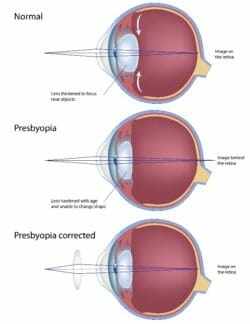Presbyopia Treatment
 The experienced team at Wiles Eye Center is dedicated to helping older patients restore clear vision by treating a variety of problems, including presbyopia. They combine state-of-the-art equipment with extraordinary experience to give Kansas City people with presbyopia customized eye care solutions.
The experienced team at Wiles Eye Center is dedicated to helping older patients restore clear vision by treating a variety of problems, including presbyopia. They combine state-of-the-art equipment with extraordinary experience to give Kansas City people with presbyopia customized eye care solutions.
What is Presbyopia?
Presbyopia is part of the eye’s natural aging process. Unlike refractive errors, which are inherent abnormalities related to the shape of the eyeball or the natural curvature of the cornea, presbyopia develops when the natural crystalline lens inside a person’s eye loses elasticity and stiffens the focusing reflex.
Along with the cornea, the lens is responsible for refracting (i.e., bending) light entering the eye to focus on the retina, or the light-sensitive tissue at the back of the eye. In youth, a healthy lens can change shape and flex forward to focus on near objects as needed. The muscles around the lens constrict to help the lens curve and change its focusing power. However, as the eye ages, the lens thickens and the muscle fibers surrounding the lens become rigid.
This makes it difficult to adjust the focus from far away to close objects or anywhere in between. Focusing may slow down or just be impossible. Sometimes presbyopia patients feel like the vision gets “stuck,” particularly while trying to read at a closer distance. Most people in their 40s or 50s experience blurred vision due to presbyopia even if they never had vision problems in the past.
Presbyopia is extremely common. As the population continues to age, an unprecedented number of adults will presbyopia. According to the U.S. Census Bureau, approximately 112 million Americans had presbyopia in 2006; by the year 2020, officials expect this number to reach 123 million.
Presbyopia Symptoms
You may have presbyopia if you:
- Have difficulty reading fine print
- Tend to hold your smartphone or other reading materials (e.g., menus, magazines) at arm’s length to see them clearly
- Suffer from eyestrain, visual fatigue or headaches after prolonged reading periods
- Experience blurred vision while transitioning from objects at different distances
- Have difficulty focusing in low light conditions
 These symptoms may worsen in low light or dim conditions.
These symptoms may worsen in low light or dim conditions.
Presbyopia affects nearly every person at some point during their lifetime. However, this condition can be treated successfully with eyeglasses or contact lenses; or, for more permanent correction, surgical treatment may be considered.
Presbyopia Treatment at Wiles Eye Center
Wiles Eye Center offers the most comprehensive presbyopia treatments. Bifocal, trifocal or “no-line” progressive lenses are frequently used in eyeglasses to successfully compensate for presbyopia. Similarly, contact lenses are effective in many patients.
Many patients prefer permanent correction and freedom from corrective eyewear. Patients can choose refractive lens exchange (RLE), which is virtually identical to cataract surgery, except that the lens being replaced is clear and not clouded by cataracts. During RLE, the surgeon replaces the ineffective, aging natural lens with a new, intraocular lens (IOL), which restores visual acuity and allows patients to see clearly up close, far away and in between. Wiles Eye Center uses the Crystalens HD, ReSTOR Multifocal and Tecnis Multifocal IOLs for this purpose. Each IOL has its own unique features; our doctors can recommend the most suitable lens or lens options, depending on the patient’s vision needs and eye health. More than 95 percent of our Kansas City and St. Joseph presbyopia patients show improvement in their vision with these state-of-the-art IOLs.
Another surgical treatment option for presbyopia is a modified version of LASIK called monovision LASIK. During this procedure, the eye surgeon corrects the distance vision in one eye (usually the dominant eye) and corrects the non-dominant eye so it is slightly nearsighted. Together, the eyes work together to see well at all distances without glasses.
Corneal inlays are yet another safe and reliable way to reduce or eliminate the need for corrective eyewear in patients with presbyopia. These small plastic rings are implanted into the cornea of one eye. They have a small central opening that acts like a pinhole camera, allowing only focused light to enter the eye to see nearby objects. Unlike RLE or monovision LASIK, corneal inlays are reversible and can be removed if patients are not satisfied with the results.
Frequently Asked Questions About Presbyopia
Does everyone get presbyopia?
Yes, presbyopia is an unavoidable part of the aging process within the eye.
How do I know if I have presbyopia?
A common sign of presbyopia is having to hold reading material farther away — i.e., at arm’s length — in order to see the text clearly. Another indication of presbyopia is the need for brighter light to read or work on a computer.
How does presbyopia affect everyday life?
Presbyopia affects patients differently. Generally, our patients with presbyopia describe loss of near vision that in turn causes difficulty with simple tasks, like sending a text message, seeing street signs or reading the label on a prescription medicine bottle. Many of our patients say they have to squint or strain their eyes to read, and as a result regularly experience headaches, migraines and/or eye fatigue.
Do I need to wear glasses for presbyopia?
Many people with presbyopia rely on reading glasses or “readers” for near vision. However, if you do not wish to wear reading glasses, the eye doctors at Wiles Eye Center offer different treatment options.
You could undergo refractive lens exchange, which replaces your natural lens with an artificial lens to restore clear near vision. Alternatively, you could undergo laser vision correction, which permanently alters the shape of your corneas to improve your eyes’ focusing power.
Will LASIK fix presbyopia?
Standard LASIK surgery to correct farsightedness will not correct presbyopia. The more appropriate solution is a version of LASIK called monovision LASIK, which corrects one eye for distance vision and the other for near vision. During monovision LASIK, a laser is used to remove microscopic bits of corneal tissue, altering the curvature of the cornea to better focus light entering the eye.
Does untreated presbyopia lead to blindness?
No, presbyopia does not lead to blindness. It causes near vision to significantly deteriorate, and can lead to other symptoms — such as difficulty seeing clearly in low lighting conditions — but it will not cause you to go blind.
What are the benefits of refractive lens exchange for presbyopia?
Refractive lens exchange (RLE) for presbyopia restores a range of clear vision without dependence on glasses. When performed by an experienced, qualified eye doctor, RLE is very safe and has a high patient satisfaction rating. The procedure is short and requires very little recovery downtime. Getting RLE for presbyopia also eliminates the potential for developing cataracts and requiring cataract surgery later in life.
How is a corneal inlay different from refractive lens exchange?
A corneal inlay is a small device that works with the eye instead of permanently altering the eye’s structures. The inlay, which is shaped like a donut, is inserted into the cornea of the non-dominant eye. It creates a pinhole effect, allowing only focused light to enter the eye. If desired, the inlay can be removed.
How long do corneal inlays last?
Corneal inlays are designed to be a long-lasting solution to presbyopia and can last many years.
However, corneal inlays cannot prevent changes to your underlying vision prescription or other problems that can affect vision, such as the development of cataracts.
Learn More about Presbyopia Treatment
Wiles Eye Center strives to improve vision for patients of all budgets. We offer a variety of financing options to help treat patients with the latest technologies at affordable prices. Contact our office today to schedule an eye exam and learn how you can achieve renewed vision. We have partnered with CareCredit to make financing options easy for our patients. We also accept most major insurance providers.
The doctors at Wiles Eye Center are renowned as some of the most accomplished Kansas City eye care specialists – Stephen B. Wiles, MD, FACS, Erin Gilliland, MD, Rachel Tischinski, OD, and Michael Klein, OD. They also specialize in helping cataract patients restore clear vision through advanced cataract treatments with premium IOLs.
